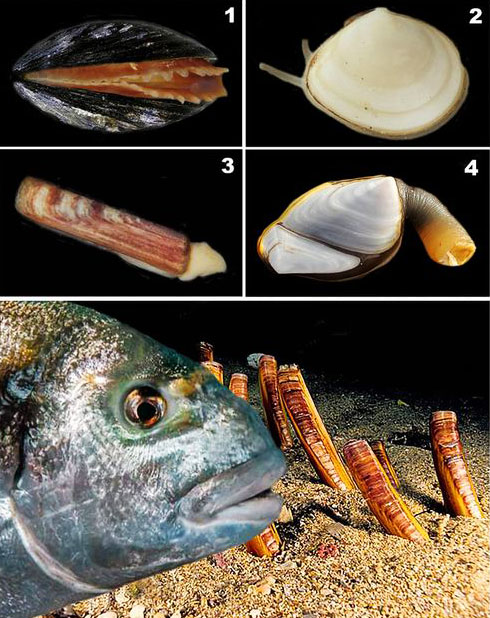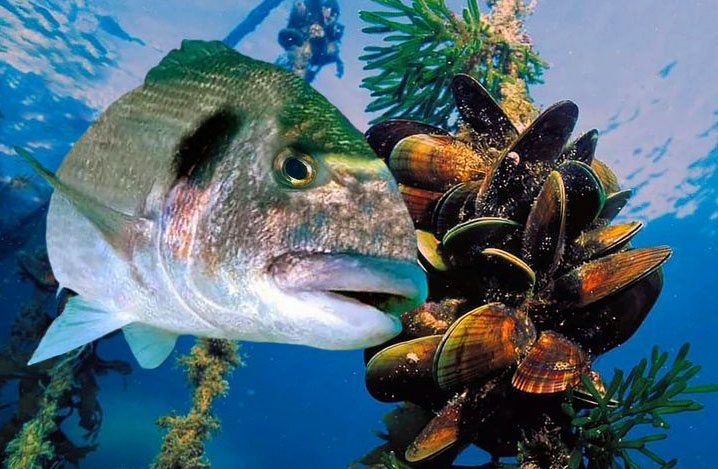What are bivalves?
The teeth of the sea bream are very powerful and its molars can crush any bait, no matter how hard it is, bivalves are one of them. I describe to you the most used for its fishing.
1-Mytilus galloprovincialis, mussel, clóchina, is an easy bait to obtain, it is sold in fishmongers, although I prefer to make it, that bait that they sell has passed at least two weeks in purifiers and that alters its properties. Of the four modalities that can be used, “plateret” in “baulet” in “ataud” and “criansó” (mussel breeding) requires a different hooking for each one of them and a specific tutorial that I will publish.
2- Abra tenuis, pechina, bonbon, it is a difficult bait to obtain, I order it from a professional tellinero on foot that is those that usually take them out, it does not have much commercial value and you can keep it, it is a very fragile and brittle beach clam, to hook it requires a special technique, in a bucket with seawater, when it opens a little the valves to breathe to insert the hook, she alone when noticing it closes them and presses holding the hook, the sea bream takes it with greediness, I have been able to verify as in an area in which there were many fishermen fishing to sliding buoy with criansó as another fisherman has arrived fished and baiting with that type of bait and all the sea bream of the area have been for him.
3- Ensis ensis, razorfish, is an easy bait to obtain, it is sold in fishmongers, but it has the same problem, it has spent a lot of time in purifiers and that alters its properties, I harvest them in summer in a beach of calm and clear waters I get into the water with water by the waist and a plastic bag with salt, you see the hole where it is lodged, you introduce your hand with a pinch of that salt and you throw it in that hole, they emerge immediately and you can catch them, to hook them open a little introduce in the slot the two-hook rig and then liquefy their whole body.
4- Anatifa anatifera, goat’s foot, false barnacle, you can get them when there is a storm and they come to the beach attached to all kinds of objects, the hooking is easy, insert the hook through the opening they have and then liquefy.

There are a number of different bivalves that can be fished for, but some of the most popular include oysters, clams, and mussels. Each type of bivalve has its own unique benefits and drawbacks when it comes to fishing.
For example, oysters are a popular choice because they are easy to catch and they have a high flesh-to-shell ratio. However, they also tend to spoil quickly once they are out of the water. Clams are another good option because they are abundant in many coastal areas and they keep well once they have been killed. Mussels, on the other hand, have a strong flavor that not everyone enjoys and they can be difficult to clean.
There are a few different types of bivalves that can be used for fishing, each with its own advantages and disadvantages. Here is a quick overview of some of the more popular options:
- Clams – Clams are a good choice for fishing because they are very common and can be found in many different habitats. They are also relatively easy to clean and cook. However, they are not particularly large, so you may not get much fish if you only use clams as bait.
- Mussels – Mussels are another good option for bait, as they are often plentiful and easy to find. They are also fairly easy to clean and prepare. The main downside to using mussels is that they tend to be quite small, so you may not get much fish if you only use them as bait.
- Worms – Worms are a popular choice for fishing because they are easy to find and usually plentiful. They are also easy to clean and prepare. However, worms can be difficult to keep alive for long periods of time, so you may need to replace them frequently.
- Maggots – Maggots are often used as bait by fishermen because they are easy to find and usually plentiful. They are also easy to clean and prepare. However, like worms, maggots can be difficult to keep alive for long periods of time, so you may need to replace them frequently.
Many times I have heard a saying that says “you have less memory than a fish” because in the case of the sea bream it must be an exception.
I have observed that they have a very repetitive behavior when “shellfishing” in a certain area, with the same schedule, during a cycle of consecutive days.
I have also verified that the same area where they go to spawn is repeated every year if the characteristics of that area have not changed.
I can assure you that in all my years of experience I very rarely catch a sea bream that has another hook stuck in it and part of the gamete when breaking the rig from a previous hook or from many days, unlike other species such as Sea bream or glazed or the Mabra.
Of course, he remembers when from then on they become very selective in accepting any type of bait after having passed that experience.

That said, clams are generally considered to be the best choice for fishing because they’re easier to clean and cook than mussels or oysters. Clams also have a mild flavor that goes well with a variety of seasonings, making them a versatile choice for both beginner and experienced fishermen alike.
In terms of fishing for these creatures, clams are the easiest to catch because they tend to reside closer to the surface of the water. Mussels can be a little more difficult to find, but they’re well worth it once you do – they’re often called the “caviar of the sea”. Oysters are typically found at the bottom of the ocean, so they can be a bit more challenging to catch. However, they’re prized for their unique flavor, so they’re definitely worth the effort.
Mollusks: Mollusk species that can be used for fishing include mussels, oysters, scallops, clams and razor shells. These mollusk species are abundant in many coastal regions due to their ability adapt to various habitats including sandy beaches and rocky shores. All these different types have similar characteristics but suit different uses when it comes to fishing – mussels can be eaten raw while oysters are typically steamed or fried; scallops and clams provide excellent bait for larger fish; while razor shells can be ground up to make chum that attracts a variety of marine life with its scent.
Crustaceans: The other major category of bivalves is made up of crustacean species such as crab, shrimp and lobster. Again each type has unique characteristics which make them valuable for different kinds of fishing activities – crabs tend to inhabit shallow waters making them easier to catch with nets; shrimps can also be caught using nets but work better as bait due to their natural smell; finally lobsters offer an amazing combination between eating potential (as they contain large amounts of meat) as well as being able attract other marine life due its intense smell which emanates from its tail section – when wrapped around a hook this makes an irresistible temptation!
Overall all these species provide great opportunities for fishermen looking capture delicious seafood resources! With versatile applications ranging from providing succulent meals on the dinner table or invaluable bait material – it’s no wonder why so many people enjoy trying their luck hunting these creatures!
Oysters are a popular choice among anglers because they are hardy enough to survive in different environments and make up the bulk of available catch. When properly harvested from clean waters, oysters offer an excellent source of sustenance and can be cooked in many ways which makes them versatile as well. Additionally, their shells provide habitat for young fishes until maturity so healthy oyster populations also ensure more fishable numbers for us divers!
Mussels are another great option due to their delicacy and abundance. Mussels easily attach themselves to rocks or other structures making them readily accessible when fishing from shorelines or jetties. They can also be collected with ease through wading since most mussel beds will be found rather shallowly underfoot (and you don’t even need an expensive net!). Unlike oysters though, mussel meat is much softer which means they should not overcooked lest they become rubbery unlike their sturdier counterparts.
Lastly we have clams – while they tend to inhabit deeper habitats than both oysters and mussels like mudflats or sandbars – there’s lots of variety within this group ranging from hardshells such as quahog all the way down size-wise towards razor clams. While harvesting these flat shelled creatures requires some patience if done correctly your reward will sometimes consist mini meals in one single clam! (Who knew right?) Plus juveniles may get stuck within its two halves making clam digging quite profitable too!
All in all whether you choose close-by open beach targeting intertidal zones or embark upon a larger boat journey deeper offshore know that each one provides unique experiences with plenty opportunity at hand so good luck fishing bivalves everyone!
Please login or Register to submit your answer
